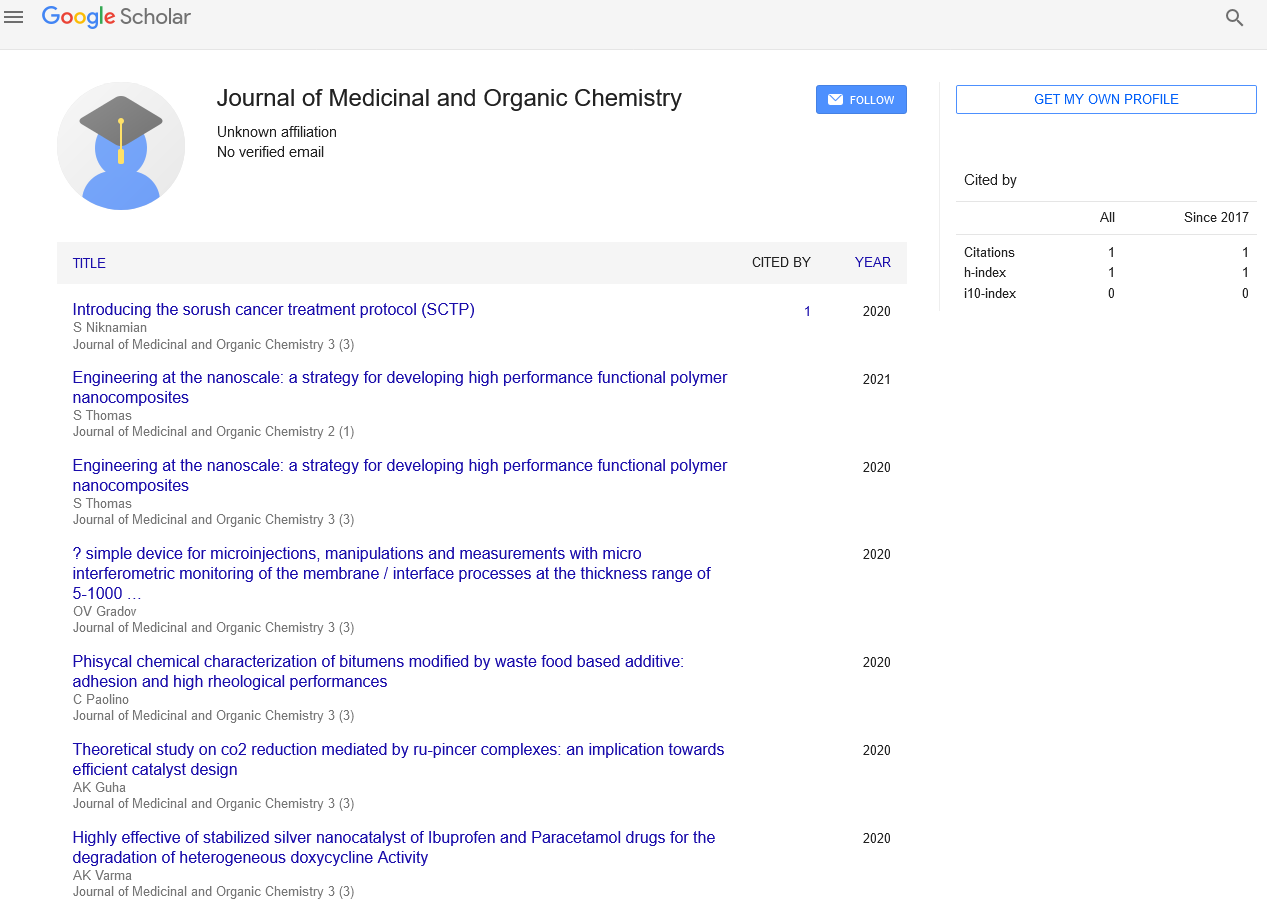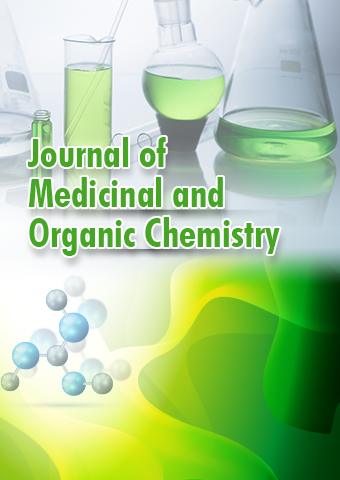Editorial - Journal of Medicinal and Organic Chemistry (2023) Volume 6, Issue 1
Medicinal and Organic Natural Products Drug Discovery
Dr. Priyanka Upmanyur*
Department of Medicinal Science and Organic Chemistry, University of RR Science and technology, India
Department of Medicinal Science and Organic Chemistry, University of RR Science and technology, India
E-mail: p.upmanyu@gmail.com
Received: 02-Feb-2023, Manuscript No. jmoc-23-89039; Editor assigned: 06-Feb-2022, PreQC No. jmoc-23- 89039; Reviewed: 13- Feb-2023, QC No. jmoc-23-89039; Revised: 23-Feb- 2023, Manuscript No. jmoc-23-89039 (R); Published: 28-Feb-2023; DOI: 10.37532/jmoc.2023.6(1).07-09
Abstract
Since ancient times and in folklore, natural products have been used to treat a wide variety of ailments. A wide variety of bioactive secondary metabolites from terrestrial and marine sources were discovered using traditional natural product chemistry methods. Numerous of these natural products are currently being considered as drug candidates. The purpose of this brief overview is to draw attention to historically significant bioactive marine and terrestrial natural products, their use in folklore, and methods of dereplication to speed up the discovery process. Additionally, a discussion of how the chemistry of natural products has led to the discovery of numerous drug candidates; the future of natural product chemistry, the use of advanced hyphenated spectroscopic techniques to aid in their discovery, and finally the adoption of metabolomic profiling and dereplication strategies for the comprehensive study of natural product extracts will all be discussed.
Keywords
Natural products • Secondary metabolites • Drug discovery • Bioactivity • Metabolomics • dereplication • Plants • Sponges • Algae • Fungi
Introduction
Natural products have proven to be the most effective means of obtaining drug leads. However, there has been a slight decline in interest in their recent use in drug discovery and development efforts. However, natural products continue to provide unique structural diversity in comparison to conventional combinatorial chemistry, making it possible to discover primarily novel lead compounds with low molecular weights. Since less than 10% of the world’s biodiversity has been checked for biological activity, many more useful natural lead compounds need to be found. The problem is finding a way to get to this natural chemical diversity [1].
Traditional medicines, remedies, potions, and oils have all been used to describe the use of natural products as medicines throughout history. Many of these bioactive natural products have yet to be identified. Through palatability tests or untimely deaths over hundreds of centuries, man has experimented by trial and error in search of readily available foods for the treatment of diseases [2]. This is the primary source of knowledge regarding the uses of natural products from medicinal plants. The plant genus Salvia, which is found in the southwestern United States and northwestern Mexico and was used by Indian tribes in southern California to aid in childbirth, is one example. Male new-born babies were believed to have been “cooked” in the hot Salvia ashes because it was believed that these babies grew up to be the strongest and healthiest members of their tribes and were immune to all respiratory illnesses for life [3].
During hot days, the Alhagi maurorum Medik plant produces a sweet, gummy substance from its stems and leaves. It has been documented and asserted by the Ayurvedic people that the plant aids in the treatment of anorexia, constipation, dermatosis, epistaxis, fever, leprosy, and obesity [4]. This gummy sap is known as “manna” and consists primarily of melezitose, sucrose, and inverted sugar. Israelis also used it, boiling the roots and drinking the extract to stop bloody diarrhea. The Konkani people used the plant to treat asthma by smoking it, and the Romans used it to treat nasal polyps. The root of the plant Ligusticum scoticum Linnaeus, which was used as a sedative in the Faeroe Islands and was eaten raw first thing in the morning in Northern Europe and Eastern North America, was a remedy for flatulence and an aphrodisiac [5]. Central and southern Europe, Western Asia, North Africa, North America, and New Zealand are all home to Atropa belladonna Linnaeus. Because of its well-known poisonous nature, it was firmly excluded from the compilation of folk remedies and appeared to have been accepted as dangerous to handle or experiment with.
Medicinal natural products from other sources
The birch-growing fungus Piptoporus betulinus was steamed into charcoal, which was used as an antiseptic and disinfectant. After being cut into strips, P. betulinus was used to stop bleeding and was also found to make very comfortable corn pads. Another example is the field mushroom Agaricus campestris Linnaeux ex Fries, which can be found in the Caribbean and the northern and southern temperate zones. It was said that milk had been used to stew A. campestris to treat throat cancer [6].
Lichens were valued far more highly than oriental spices from the 17th to the 18th centuries and were utilized as dyes. Despite the fact that their applications in folklore are well-documented, no drugs derived from lichen have yet been approved for sale. Since the early times of the Chinese and Egyptian civilizations, lichens have been used to make perfumes, cosmetics, and medicines. Usnea dillenius ex Adanson, which was traditionally used to treat diseases of the scalp, is one wellknown example. It is still sold in pharmacies as an ingredient in shampoos that treat dandruff and in Ireland to treat sore eyes [7]. The lichen U. subfloridana Stirton was made into a lotion by boiling it with butter and tobacco, cooling it, and then applying it. Brown dyes were made from Parmelia omphalodes (Linnaeus) Acharius, which grows abundantly in the British Isles. It was traditionally sprinkled on stockings at the start of a journey in the Highlands to prevent foot inflammation, and in Ireland, it was used to treat burns, cuts, and severe sores under the chin.
In contrast, very few traditional medical uses have been reported for the marine environment. A beverage made from the red algae Chondrus crispus and Mastocarpus stellatus was used as a folk remedy for colds, sore throats, chest infections, including tuberculosis. Additionally, the alga was boiled in milk or water and utilized for burns and kidney problems. Additionally, it was discovered that daily consumption of three spoonfuls of the juice of the red alga Porphyra umbilicalis Kützing, followed by a three-week fast, was effective against cancer, particularly breast cancer. In the Aran Islands, P. umbilicalis has also been said to help with indigestion. Additionally, it was boiled and given to cows as a springtime constipation remedy [8].
Natural products from Fungi
For thousands of years, both macro and micro fungi have been a part of human life. They were used for medicinal purposes in traditional medicine, as food in the preparation of alcoholic beverages, and for cultural purposes. Their applications now include enzymes, biological controls, antibiotics, and other pharmacologically active products thanks to advancements in microbiology [9].
One of the most well-known natural product discoveries made from a fungus (microorganism) is penicillin, which Fleming discovered in 1929 from the fungus Penicillium notatum. For the in vivo experiments that ultimately saved numerous lives and earned Chain and Florey, along with Fleming, the 1945 Nobel Prize in Physiology and Medicine, a counter current extractive separation method that produced 7 in high yields was required. This discovery led Chain, Florey, and coworkers to re-isolate the bacteria, conduct clinical studies in the early 1940s, and eventually commercialize synthetic penicillins, reshaping drug discovery research. From 1942 to 1944, when the first clinical data on penicillin G were published, a worldwide search for bioactive natural products and microorganismderived antibiotics began. Old methods for detecting -lactams were still being used until 1968, when it was determined that all natural -lactams had been found [10]. However, this was not the case because new screening methods were introduced in the 1970s, which led to the discovery of novel antibiotic structural classes like the isolation of the antibiotics norcardicin, imipenem, and aztreonam, as well as tests for the inhibition of -lactamases and specificity for sulphurcontaining metabolites. In addition to the novel class of broad-spectrum antibiotics known as glycylcyclines, there are currently nine clinical trials or drug registrations for -lactamsin.
Conclusion
In a nutshell, we propose that natural product discovery processes and metabolomics technologies can benefit from one another. First, by making more identifiers in our metabolomics data, we might be able to create novel structures that can be tested for bioactivity in any disease that is being studied. Chemical characterization procedures for a wide range of natural resource species will also benefit from enhanced and increased throughput thanks to multi-parallel analysis made possible by metabolomics technologies. Second, as previously stated, natural product chemists have accumulated compound libraries of both active and inactive pure compounds over the course of their careers. These libraries can now be analysed to build mass spectral and NMR spectral libraries, thereby enhancing biological interpretations of metabolomics data. Increased detection of small molecule compounds that are measurable in biological systems (i.e., primary and secondary metabolites) has been made possible by advancements in analytical instrumentation and sophisticated hyphenation of separation techniques with high-sensitivity detectors. These advancements will undoubtedly now be utilized to advance the discovery of natural product chemistry in order to identify potential novel drug candidates that will aid in the maintenance of health and the fight against disease and illness.
Acknowledgement
None
Conflict of Interest
None
References
- Kittakoop P, Mahidol C, Ruchirawat S et al. Alkaloids as important scaffolds in therapeutic drugs for the treatments of cancer, tuberculosis, and smoking cessation. Curr Top Med Chem. 14: 239-52 (2012).
- Russo P, Frustaci A, Del Bufalo A et al. Multitarget drugs of plants origin acting on Alzheimer's disease. Curr Med Chem. 20: 1686-93(2013).
- Prommer E, Ziconotide: a new option for refractory pain. Drugs of Today. 42: 369-78 (2006).
- Dossey AT, Insects and their chemical weaponry: new potential for drug discovery. Natural Product Reports. 27: 1737-57 (2010).
- Mayer AM, Glaser KB, Cuevas C et al. The odyssey of marine pharmaceuticals: a current pipeline perspective. Trends Pharmacol Sci. 31: 255-65(2010).
- Bowersox SS, Luther R. Pharmacotherapeutic potential of omega-conotoxin MVIIA (SNX-111), an N-type neuronal calcium channel blocker found in the venom of Conus magus. Toxicon. 36: 1651-8 (1998).
- Petek BJ, Loggers ET, Pollack SM et al. Trabectedin in soft tissue sarcomas. Marine Drugs. 13: 974-83 (2015).
- Beghyn T, Deprez-Poulain R, Willand N et al. Natural compounds: leads or ideas? Bioinspired molecules for drug discovery. Chem Biol Drug Des. 72: 3-15 (2008).
- Koehn FE, Carter GT, The evolving role of natural products in drug discovery. Nature Reviews Drug Discovery. 4: 206-20 (2005).
- Lewis RJ, Dutertre S, Vetter I et al. Conus venom peptide pharmacology. Pharmacological Reviews. 64: 259-98 (2012).
Indexed at, Google Scholar, Crossref
Indexed at, Google Scholar, Crossref
Indexed at, Google Scholar, Crossref
Indexed at, Google Scholar, Crossref
Indexed at, Google Scholar, Crossref
Indexed at, Google Scholar, Crossref
Indexed at, Google Scholar, Crossref
Indexed at, Google Scholar, Crossref
Indexed at, Google Scholar, Crossref

